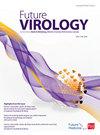H型乙型肝炎病毒C107R突变对体外乙型肝炎表面抗原检测及干扰素-β-1a治疗的影响
IF 1.4
4区 医学
Q3 VIROLOGY
引用次数: 0
摘要
目的:评价乙型肝炎病毒(HBV)基因型H(HBV/H)与小表面HBV蛋白(HBs)C107R突变对乙型肝炎表面抗原(HBsAg)检测、TGFB1、CAT和IFNB1A表达的影响,以及对IFN-β-1a治疗的反应。方法:构建HBV/H野生型和HBs C107R变体复制子,并将其转染到肝星状细胞和/或Huh7中,然后用IFN-β-1a处理。分析HBsAg、HBV-DNA、pgRNA、TGFB1、CAT和IFNB1A的表达。通过AlphaFold蛋白预测因子预测野生型和C107R的3D HBs结构,并评估IFN-β-1a的抗病毒效果。结果:C107R突变不影响病毒复制,但影响HBsAg血清学检测。野生型和C107R类似地修饰了基因表达,并对IFN-β-1a产生反应。结论:C107R破坏Cys107/Cys138二硫键,损害HBsAg的检测。与突变无关,与基因型a和C相比,TGFB1、CAT和IFNB1A的表达发生了变化,并且对IFN-β-1a治疗有中等反应。本文章由计算机程序翻译,如有差异,请以英文原文为准。
Influence of C107R mutation from hepatitis B virus genotype H on in vitro hepatitis B surface antigen detection and IFN-β-1a treatment
Aim: Assess the in vitro effect of hepatitis B virus (HBV) genotype H (HBV/H) with the small surface HBV protein (HBs) C107R mutation on hepatitis B surface antigen (HBsAg) detection, TGFB1, CAT and IFNB1A expression, and the response to IFN-β-1a treatment. Methods: HBV/H wild-type and HBs C107R variant replicons were constructed and transfected into hepatic stellate cells and/or Huh7 that were later treated with IFN-β-1a. HBsAg, HBV-DNA, pgRNA, TGFB1, CAT and IFNB1A expression was analyzed. 3D HBs structure from wild-type and C107R were foreseen by AlphaFold protein predictor, and IFN-β-1a antiviral effect was evaluated. Results: C107R mutation did not impact viral replication, but HBsAg serologic detection was affected. Wild-type and C107R similarly modified gene expression and responded to IFN-β-1a. Conclusion: C107R disrupts the Cys107/Cys138 disulfide bond and impairs HBsAg detection. Independently of the mutation, there were changes in TGFB1, CAT and IFNB1A expression, and a medium response to IFN-β-1a treatment compared with genotype A and C.
求助全文
通过发布文献求助,成功后即可免费获取论文全文。
去求助
来源期刊

Future Virology
医学-病毒学
CiteScore
4.00
自引率
3.20%
发文量
84
审稿时长
6-12 weeks
期刊介绍:
Future Virology is a peer-reviewed journal that delivers essential information in concise, at-a-glance article formats. Key advances in the field are reported and analyzed by international experts, providing an authoritative but accessible forum for this ever-expanding area of research. It is an interdisciplinary forum for all scientists working in the field today.
 求助内容:
求助内容: 应助结果提醒方式:
应助结果提醒方式:


